Jerusalem artichoke
Common Names: sunroot, sunchoke, earth apple or topinambour, Canadian potato, sunflower root, wild sunflower
Driving around in upstate New York in late summer you can spot Jerusalem artichoke growing just off the road. Take a walk near old farms and just off the path you can spot small plots of these native plants growing. This edible plant is actually a species of sunflower native to eastern North America – however due to its food value (and probably its flower) it has been introduced worldwide. Just another example of man bringing a new plant to an area to become an “invasive species”. The root system of this wild food is fibrous with thin cord-like rhizomes that can grow as long as 50 inches. Usually apparent at the tips of rhizomes are whitish to pinkish tubers that are irregular in size and shape and resemble a slender potato with knots.
Description:
The Jerusalem artichoke is a tall perennial plant. It can grow up to 10’ in height. Its stems are strong upright in growth. They have “hairs” along the stem. The leaves are opposite or in whorls of three on the bottom and alternately arranged near the top. The top of the leaves are covered with short hairs and are 4 to 10 inches long and 1 1/2 to 5 inches wide broadest at the base and tapering at the tip. All leaves have toothed margins. The flowers are bright yellow as can be seen in the picture. The flower head is a rounded central disc approximately 1 ½” to 2” wide which has approximately 10 – 20 – 1 ½” to 2 ½” flowers rays attached. Each plant will have several flowers on small stems.
Habitat:
You can find Jerusalem artichokes in damp or rich thickets, waste areas, old fields, along roadsides and even in peoples gardens – either as a known vegetable or just a nice yellow flower.
Location:
You can find clusters of these wild flowers growing from southern Saskatchewan south into Kansas and eastward into Quebec down to Georgia. Frankly since many people have attempted to grow jerusalem artichoke as a food source, you can find this plant growing where ever conditions are right – again “invasive”
Edible:
The tuber is the edible part of this plant. If you wait until after a frost the inulin in the tubers will start turning to sugar thus making it sweeter. You can prepare the tuber just as you would a potato – roast, bake, boil, eat it raw, dry and grind into a flour. It is extremely versatile.
“Jerusalem artichokes get their sweetness from a unique sugar called inulin, which the body metabolizes much more slowly than it does other sugars. This makes the veggie a preferred food for diabetics, and for anyone who wants to avoid eating simple sugars and starches. Jerusalem artichokes are rich in iron, potassium and a range of B vitamins.” 2
Notes of Interest:
Jerusalem artichokes were cultivated by the Native Americans, in fact Samuel de Champlain found domestically grown plants at Cape Cod in 1605.
Truly a plant of many uses, the jerusalem artichoke can be grown for: human consumption, alcohol production, fructose production and livestock feed.
“Dehydrated and ground tubers can be stored for long periods without protein and sugar deterioration. Tubers can be prepared in ways similar to potatoes. In addition, they can be eaten raw, or made into flour, or pickled.” 1
A 25-square-foot planting can produce more than 100 pounds of harvested tubers. 2
The sugars from one acre of Jerusalem artichoke can produce 500 gallons of alcohol, which is about double the amount produced by either corn or sugarbeet. 3
1. Alternative Field Crops Manual – University of Wisconsin
2. Mother Earth News
3. Ohio State University – Ohio Perennial and Biennial Weed Guide
Back to edible wild plant index